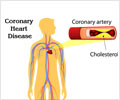A chemical drink is capable of increasing the supply of oxygen to the damaged cardiac muscle in heart attack patients, thus giving them an energy boost, according to a group of French researchers.
Jean-Marie Lehn and his colleagues, at the University of Strasbourg, came to this conclusion after carrying out experiments on ailing mice, wherein the drink-formed by dissolving the drug myo-inositol trispyrophosphate (ITPP) in water-boosted exercise levels in the animals by 35 per cent.The researcher revealed that the drink had been designed to make haemoglobin release more of its oxygen than normal.
They said that when it was given by injection into the abdomen, the subjects' exercise levels rose a massive 60 per cent.
"ITPP doesn't deliver oxygen itself, but makes haemoglobin able to release a larger amount of oxygen to tissues," the Sun quoted Lehn as saying.
He revealed that haemoglobin generally releases only 25 per cent of oxygen during one circuit of the body. But when ITPP binds to haemoglobin, he adds, it releases 35 per cent more than usual, boosting supplies of oxygen to tissues without people having to inhale any extra air.
The researcher even said that the effect from a single dose was found to last for almost a week, which means that the patient need not take ITPP every day.
Advertisement
Lehn hopes to begin clinical trials on humans "as soon as possible".
Advertisement
"It could be very easily detected," New Scientist magazine quoted him as saying.
Lehn revealed that his team were continuing their research to determine exactly how ITPP interferes with haemoglobin to make it give up more oxygen.
A report on Lehn's study has been published in the journal Proceedings of the National Academy of Sciences.
Source-ANI
SAV














